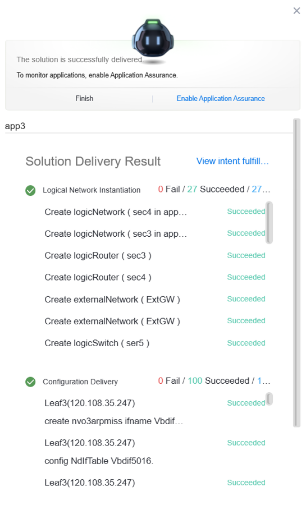2.4- Application Scheme Implementation
The simulation in the previous test confirmed that the configurations could be reliably deployed to the network devices. Based on this outcome, we delivered the configuration scheme to the devices. Deployment began with App3, which was successfully applied, as shown by the solution delivery result in Figure 20.

Figure 20: App3 Deployment Report
The deployment of App1 and App2 and the inter-application communication between them were also deployed successfully.
To verify the correct deployment of the applications and inter-application communication, we deployed virtual machines connected to the different leaf nodes where the services were deployed, and used ICMP to verify the connectivity. All pings were successful, indicating the proper deployment of the services.
To extend the test further, we defined an additional intent for the application (App6), which includes a firewall connected to the border leaf. This application consists of a single security zone (sec7). NCE-Fabric managed this intent, generated a solution, and deployed it successfully, just like the other applications.
It’s worth noting that the firewall had to be initially onboarded manually, as NCE-Fabric currently does not support zero-touch provisioning for firewalls due to their complexity.
Configuration Backup
Creating a configuration backup and being able to roll the network back to a previous state are valuable in cases of unexpected behavior or failed changes.
NCE-Fabric supports both periodic and manual backup creation. After deploying all applications to the network, we created two manual snapshots for our test. One snapshot was created at the tenant level, capturing the state of all previously configured applications. The second snapshot covered the entire network, providing a complete backup of the deployed configuration across the fabric.
After successfully creating the snapshots, we rolled back the configuration related to the inter-application connectivity between App1 and App2. To verify the rollback, we performed a ping test between the two applications, which failed as expected, confirming that the rollback removed the relevant connectivity settings.
We then restored the tenant configuration from the previously created snapshot. The restoration was completed successfully, and connectivity between App1 and App2 was re-established. We verified this by performing a ping test, which confirmed that communication between the applications was functioning as expected.
To test the network-wide backup, we took App3 offline, including all associated services, and then performed a restoration using the network-wide configuration snapshot. The restoration was completed successfully, as shown in Figure 21, and the connectivity for App3 was restored, as confirmed by a successful ping test.

Figure 21: Backup and Restoration Log
However, it's important to note that network-wide backup restoration is intended as an emergency operation for critical situations, such as major outages or unresolved faults. During the process, NCE-Fabric also reverted its own configuration to the snapshot state, making it temporarily unreachable.
This test confirms that NCE-Fabric fulfills the Level 4 requirement for the Solution Implementation capability, as defined in the ETSI GR ENI 049 specification.
| < Previous | Next > |
